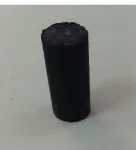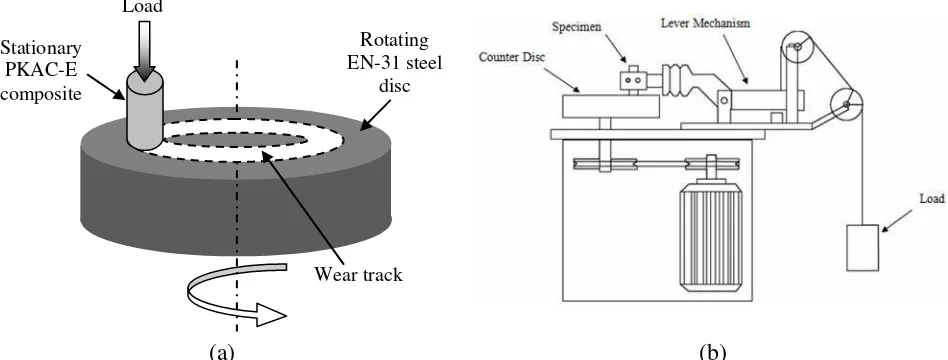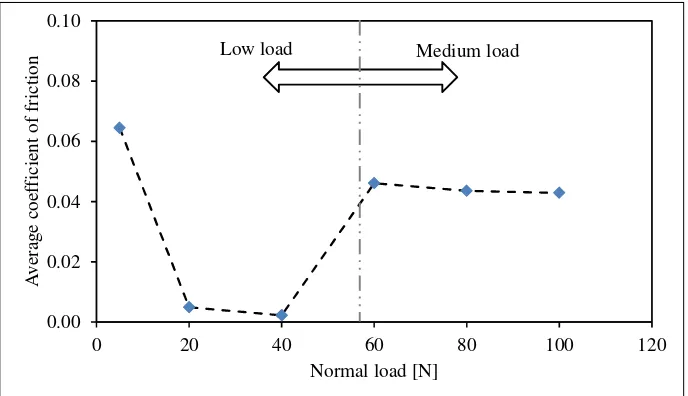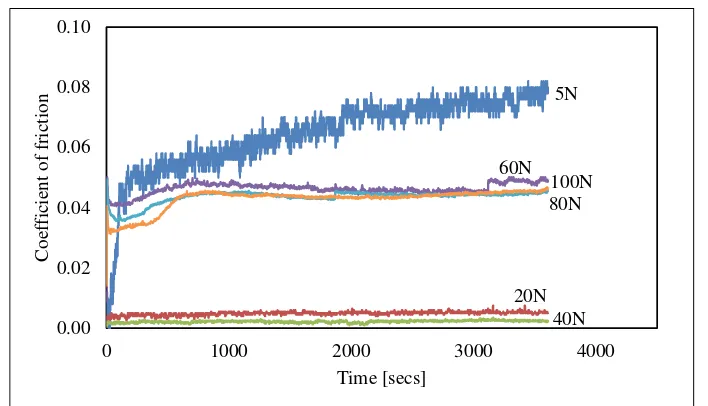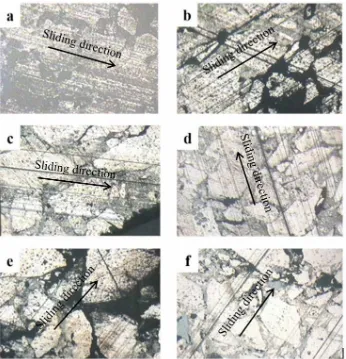Received 04 Jun 2014; received in revised form 12 July 2014; accepted 6 Sept 2014
To cite this article: Chua et al. (2014). Potential of palm kernel activated carbon epoxy (PKAC-E) composite as solid lubricant: Effect of load on friction and wear properties. Jurnal Tribologi 2, pp.31-38.
Potential of palm kernel activated carbon epoxy (PKAC-E) composite as solid lubricant: Effect of load on friction and wear properties
K.W. Chuaa, M.F.B. Abdollaha,b,*, N.A. Mat Tahira, H. Amiruddina,b
a
Faculty of Mechanical Engineering, Universiti Teknikal Malaysia Melaka, Hang Tuah Jaya, 76100 Durian Tunggal, Melaka, Malaysia.
b
Centre of Advanced Research on Energy, Universiti Teknikal Malaysia Melaka, Hang Tuah Jaya, 76100 Durian Tunggal, Melaka, Malaysia.
*
Corresponding author: [email protected]
HIGHLIGHTS
Wear rate and friction coefficient of PKAC-E composite decreases with applied load.
However, at higher load, friction coefficient increases slightly and remains almost invariant with applied load.
Palm kernel activated carbon epoxy composite (PKAC-E) has a potential to act as a self-lubricating material at low load under unlubricated conditions.
ABSTRACTS
The aim of this study is to investigate the effect of load on the friction and wear properties of palm kernel activated carbon epoxy (PKAC-E) composite. The PKAC-E composite specimen was fabricated by hot compression molding method. Dry sliding test was performed by using a pin-on-disc tribometer at various load conditions with constant sliding speed and distance. The experimental results show that wear rate and friction coefficient of PKAC-E composite decreases with applied load. However, at higher load, friction coefficient increases slightly and remains almost invariant with applied load. In addition, some adhesive and abrasive wear types were identified on the worn surfaces. The main conclusion of this work is that PKAC-E composite show unique properties as solid lubricant at low load under unlubricated conditions.
Keywords:
| Palm kernel activated carbon | wear | coefficient of friction |
1.0 INTRODUCTION
For a decade, many researchers have investigated different types of solid lubricants as reinforcement or coating materials for tribological applications (Erdemir et al., 2000; Heimberg et al., 2001; Tokoroyama et al., 2006; Liu et al., 2009; Baradeswaran, 2011; Abdollah et al., 2012; Masripan et al., 2013). Recently, the potential of local waste materials as substitute reinforcement in fabrication of lightweight materials, such as metal matrix composites and polymer matrix composites has attracted lots of attentions due to its self-lubricating properties and adopt zero waste strategy at affordable cost (Zamri et al., 2010; Zamri et al., 2011; Aigbodion et al., 2011; Bakry et al., 2013). A few researcher found out that porous carbon also known as activated carbon, such as palm shell activated carbon (PSAC), exhibited its potential to act as a self-lubricating material when reinforced in aluminium alloy, which significantly improved wear resistance by increasing PSAC content up to 10 wt.% (Zamri et al., 2010; Zamri et al., 2011). Gomes et al., 2001 stated in his study of carbon-carbon composites, the friction coefficient is almost independent in sliding speed but highly affected by test temperature. In general, as observed from prior studies, there are a limited number of studies to investigate the potential of activated carbon materials as solid lubricants in polymer matrix composites. Hence, the goal of this paper is to study the effect of applied load on the friction and wear properties of palm kernel activated carbon epoxy (PKAC-E) composite.
2.0 EXPERIMENTAL
2.1 Specimen preparation
In this study, the materials used are palm kernel activated carbon (PKAC), West System 105 Epoxy Resin (105-B) and West System 206 Slow Hardener (206-B). All specimens were fabricated by hot compression molding method. The PKAC particulate was ground into smaller particle and mixed with epoxy resin (E) and hardener at a composition ratio of 70 wt.% PKAC and 30 wt.% E. The compression process was conducted using hot press machine at 80oC and 2.5 MPa of compression pressure. The green specimen was then cured under room temperature for 2 – 3 days. The length and diameter of the specimen was 30 mm and 10 mm, respectively, as shown in Figure 1.
2.2 Dry sliding test
The dry sliding testing was performed to determine the friction coefficient and wear rate between the contact surfaces using a pin-on-disc tribometer. The testing procedure followed the ASTM standard G99-95a (Standard Test Method for Wear Testing with a Pin-on-Disk Apparatus). All tests were performed at room temperature with a constant sliding speed and distance at 200 rpm and 3770 m, respectively. Prior to the sliding test, pin was ground by sliding against 600grit silicon carbide (SiC) paper at one end. Then, both pin and disc were cleaned using acetone in an ultrasonic bath. As illustrated in Figure 2, The pin was then mounted vertically on the tester arm at one end and the other pin surface was hold against the rotating EN-31 carbon alloy steel disc (hardened to HRC 62; ground to Ra = 0.8µm) with a diameter and thickness of 16.5 mm and 8 mm,
respectively. A coefficient of friction and frictional force encounter by the ball in sliding were measured by a PC based data logging system. The coefficient of friction is then being determined as follows:
W F
=
µ (1)
Where Fis the frictional force in N and W is the applied load in N.
PSAC-Al composite
Rotating EN-31 steel
disc Load
Stationary PKAC-E composite
Wear track
(a) (b)
Figure 2 (a) Illustration and (b) schematic diagram of the sliding test using a pin-on-disc tribometer
The wear at the pin was recorded by measuring the mass of the pin before and after the wear test. The mass loss in mass unit is converted to the volume loss by dividing with bulk density of material. The specific wear rate is then being determined as follows:
ρ
loss
loss m
WL V
k= loss (3)
Where Vlossis the volume loss in mm3, mlossis the mass loss in g, ρ is the bulk density of
material in g/mm3, k is the specific wear rate of material in mm3/Nmm, W is the applied load in N and L is the sliding distance in mm.
The worn surfaces morphology was observed using a digital microscope and profilometer.
3.0 RESULTS AND DISCUSSION
Figure 3 indicates the friction coefficient decreases with the increase of applied load within the observed range though from 60 N, it increases slightly and remains almost invariant with applied load (Figure 4). The frictional heating, which will induce tribofilm formation, is believed to be responsible for the decrease of friction with the increase of applied load. There was a strong dependence of tribofilm formation on temperature (Komvopoulos et al., 2002). The tribofilm generated from the preferential wear of the soft carbon material results in a carbon based tribofilm adhering on the worn surface which breaks the adhesive joints between the asperities and thereafter leads to low friction (Luo, 2013). However, as stated by Bakry et al. 2013, at higher load, the tribofilm was broken and carbon shows a drastic reduction in lubricity; consequently increases friction coefficient.
0.00 0.02 0.04 0.06 0.08 0.10
0 20 40 60 80 100 120
A
v
er
ag
e
co
ef
fi
ci
en
t
o
f
fr
ic
ti
o
n
Normal load [N]
Low load Medium load
0.00 0.02 0.04 0.06 0.08 0.10
0 1000 2000 3000 4000
C
o
ef
fi
ci
en
t
o
f
fr
ic
ti
o
n
Time [secs]
5N
60N 100N 80N
20N 40N
Figure 4 Comparison of friction coefficient as a function of time at different load
As regard to the wear, Table 1 shows the distribution of calculated wear rate with applied load. As shown in Figure 5, the wear rate of PKAC-E composite decreased significantly with applied load. From Figure 6, worn surfaces of the material were characterized by some adhesion wear and abrasive wear. However, at higher load, adhesion wear was slightly reduced with smoother surfaces and show signs of fine scratches. A reduction in adhesion is directly responsible for the reduction in friction and wears (Zhao et al., 2014). These results agree with the calculated wear rate values as in Figure 5. Among the experiments conducted there was no seizure condition noticed.
Table 1 Weight of specimen before and after tribo testing with calculated wear rate
Sample Load [N] m1 [g] m2 [g] mloss [g] k [mm3/Nmm]
A 5 3.3483 3.3443 0.0040 0.7800
B 20 3.1647 3.1643 0.0004 0.0780
C 40 3.0090 3.0073 0.0017 0.3315
D 60 3.4947 3.4943 0.0004 0.0780
E 80 3.5783 3.5767 0.0016 0.3120
0.0 0.2 0.4 0.6 0.8 1.0 1.2 1.4 1.6 1.8
0 20 40 60 80 100 120
S
p
ec
if
ic
w
ea
r
ra
te
,
k
[m
m
3/N
m
m
]
Normal load [N]
x
1
0
-7
Figure 5 Relationship between applied loads and wear rate of PKAC-E composite
CONCLUSIONS
As a conclusion, it was found that the wear rate and friction coefficient of PKAC-E composite was decreasing with the increasing in applied load. However, at higher load, friction coefficient increases slightly and remains almost invariant with applied load. In addition, some adhesive and abrasive wear types were identified on the worn surfaces. From the overall findings, PKAC-E composite show unique properties as solid lubricant at low load under unlubricated conditions.
ACKNOWLEDGEMENTS
The authors gratefully acknowledge contributions from the members of the Green Tribology and Engine Performance (G-TriboE) research group. This research was supported by the grant from the Ministry of Education Malaysia (Grant No.: ERGS/2013/FKM/TK01/UTEM/02/04/E00016).
REFERENCES
Abdollah, M.F.B., Yamaguchi, Y., Akao, T., Inayoshi, N., Miyamoto, N., Tokoroyama, T. and Umehara, N., 2012. Deformation–wear transition map of DLC coating under cyclic impact loading. Wear, 274–275, 435–441.
Aigbodion, V.S., Hassan, S.B. and Agunsoye, J.O., 2012, Effects of bagasse ash reinforcement on dry sliding wear behavior of polymer matrix composite. Materials & Design, 33, 322–327.
Bakry, M., Mousa, M.O. and Ali, W.Y., 2013, Friction and wear of friction composites reinforced by natural fibres, Materials Science and Enginerring Technology, 44, 21–28.
Baradeswaran, A., 2011, Effect of graphite content on tribology behaviour of aluminum alloy-graphite composite. European Journal of Scientific Research, 53, 163–170. Erdemir, A., Eryidmaz O.L. and Fenske, G., 2000, Synthesis of diamond like carbon
films with superlow friction and wear properties. J. Vac. Sci. Technol. A, 18 (4), 1987–1992.
Gomes, J.R., Silva, O.M., Silva, C.M., Pardini, L.C. and Silva, R.F., 2001, The Effect of sliding speed and temperature on the tribological behaviour of carbon-carbon composites. Wear, 249, 240–245.
Komvopoulosa, K., Chiaroa, V., Paktera, B., Yamaguchib, E.S. and Ryasonc, P.R., 2002, Antiwear tribofilm formation on steel surfaces lubricated with gear oil containing borate, phosphorus, and sulfur additives. Tribology Transactions, 45, 568–575. Liu, L., Li, W., Tang, Y., Shen, B. and Hu, W., 2009, Friction and wear properties of
short carbon fiber reinforced aluminum matrix composites. Wear, 266, 733–738. Luo, Q., 2013, Tribofilms in solid lubricants, In: Wang, Q. Jane and Chung, Yip-Wah,
(eds.) Encyclopedia of Tribology, Springer. (In Press)
Masripan, N.A.B., Ohara, K., Umehara, N., Kousaka, H., Tokoroyama, T., Inami, S., Zushi, K. and Fujita, M., 2013, Hardness effect of DLC on tribological properties for sliding bearing under boundary lubrication condition in additive-free mineral base oil. Tribology International, 65, 265–269.
Tokoroyama, T., Goto, M., Umehara, N., Nakamura, T. and Honda, F., 2006, Effect of nitrogen atoms desorption on the friction of th CNx coating against Si3N4 ball in nitrogen gas. Tribology Letters, 22, 215–220.
Zamri, Y. and Shamsul, J.B., 2011, Physical properties and wear behaviour of aluminium matrix composite reinforced with palm shell activated carbon (PSAC), Kovove Mater., 49, 287–295.
Zamri, Y., Shamsul, J.B., Misbahul Amin, A. and Hidayah, A.Z.N., 2010, Sliding wear properties of hybrid aluminium composite reinforced by particles of palm shell activated carbon and slag. Journal of Science and Technology, 2, 79–96.
